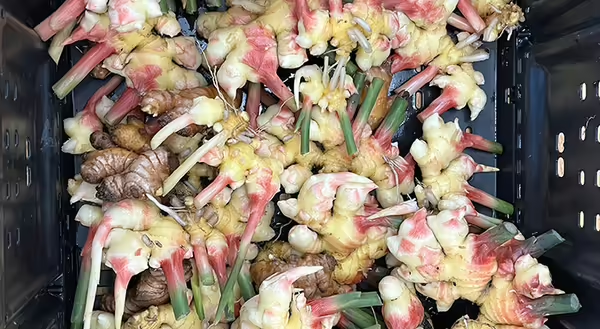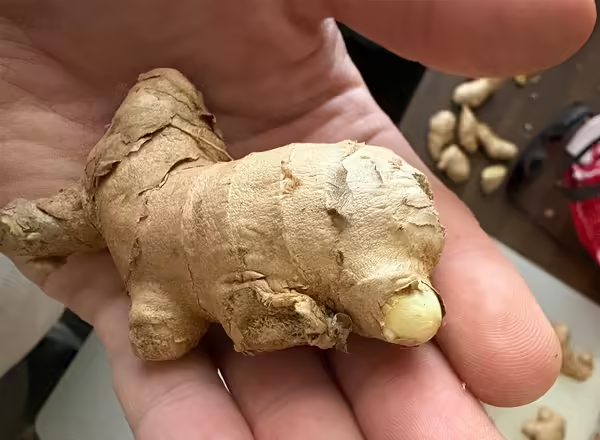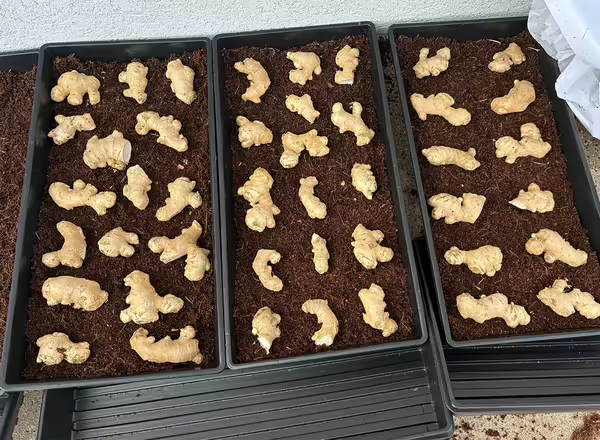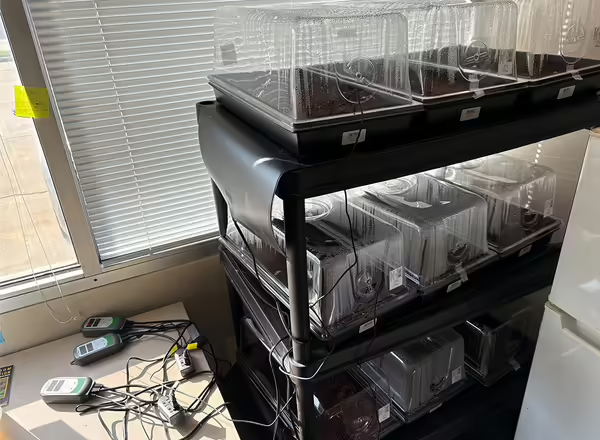
Fresh ginger rhizome (see photo) CAN be grown in Illinois, and it can fetch $20-25 per pound, retail, but is a challenging crop to grow. The best practices of ginger crop production in temperate latitudes such as Illinois are not fully understood.
In spring of 2024, Extension's Illinois Specialty Crop Block Grant proposal, “Establishing Best Practices and Evaluating Promising Varieties of Fresh Ginger Rhizome for Illinois Small Farm Production” was funded.
Our team - 7 Extension Educators and 8 small farms across Illinois – plan to grow ginger according to currently understood best practices in the 2025 and 2026 field seasons and fill in the blanks. We will test its ability to thrive in outdoor, open-field conditions, as well as in protected-culture conditions, and in large grow bags. 4 different varieties of ginger will also be evaluated, from three vendors. With the data we hope to collect in the scope of this project, we hope to publish an Illinois Ginger Rhizome Growers Guide that we hope will guide future ginger growers toward success in raising this interesting, high-value specialty crop.
On Monday, April 14th, we initiated the pre-sprout process for our fresh ginger rhizome – the first step of ginger growing for 2025.

Pre-sprouting involves cutting large, dormant ginger rhizomes down to much smaller rhizome seed pieces averaging 1-3 ounces. Each rhizome piece should have at least 1-2 growing points. Once cut, rhizome pieces are laid out in a well-ventilated space for at least 48 hours so that the cut surfaces of rhizome pieces can cure.

Once fresh cut surfaces of ginger rhizome seed pieces have cured, 3” deep, 1020 flats with holes are filled halfway with hydrated coconut coir. Then, 12-15 cured rhizome pieces are placed in each flat, 2” apart, on top of coconut coir. Rhizome pieces are then buried with moist coconut coir.
Do not overcrowd rhizomes when placing in flats, so that emerging roots from pre-sprouting rhizomes do not grow into each other. Disturbance or destruction of roots when separating sprouted rhizomes during transplanting can result in stunting of rhizomes or rhizome death. When in doubt, space rhizomes out.

Flats with holes are placed into drainage trays with no holes, and small wooden blocks, landscape rocks, etc. are placed in all four corners of trays. This is done to create space between flats and trays to allow recently hydrated coir to drain into the bottom tray after its initial hydration.
The ginger flats and trays are then placed on heat mats, which are plugged into temperature controllers set to 76F. Humidity domes are then placed over the top of flats.
Ginger (Zingiber oficinale) is a tropical, understory crop, so it prefers warm, somewhat moist conditions, especially during the pre-sprout phase. It is very important that ginger rhizomes are kept moist, warm, and humid. However, the tops of the coconut coir in each tray should be allowed to dry out about every 72 hours. The best way to keep coconut coir and rhizomes moist without soaking rhizomes is to use a large, heavy-duty, handheld spray bottle, remove humidity domes, and spray each flat well, every 24-48 hours. As with everything else in specialty crop production, the wet/dry cycle in pre-sprout is a balancing act.
Now two weeks into the pre-sprout process, the waiting game continues.
3-4 weeks after rhizomes are cut, cured, and put in moist coir, roots should begin growing in flats and green tips should emerge. Once green shoots are visible on ~ 50% of the rhizomes and are a few inches tall, the entire flat should be hardened off for 7-10 days, and then transplanted. That means that 2-3 weeks into the pre-sprout process, plans should be made for soil preparation and planting! Ginger rhizomes that are allowed to sit in flats for several weeks past this point often die from various factors.
Our team has seen evidence that ginger rhizomes can be grown outdoors, in open field conditions, depending on soil conditions and USDA Growing Zone. Soil temperature should be 55F at minimum at the time of planting, with no cold (sub-45F) weather in the two-week forecast.
More typically, ginger rhizome is planted in protected culture, (hoop houses, greenhouses, low tunnels, or related). The longer it can stay in the ground and mature, the larger the yield will be.
All the ginger I have pre-sprouted will be planted at Epiphany Farms Estate and Farm in Downs, IL, once 50% of flats show green, growing ginger tips, in a mix of protected culture and open field conditions, to test how ginger rhizome performs under different growing conditions here in the Bloomington-Normal area.
In a later issue, I will write about soil preparation, planting, fertility, irrigation, and more. Meanwhile, across the state of Illinois, dozens of collective flats worth of ginger rhizomes will soon emerge.
Sources:
Ginger, Zingiber officinale – UW-Madison Extension
https://hort.extension.wisc.edu/articles/ginger-zingiber-officinale/
Ginger and Turmeric a High Value Crop for Local Growers – NC State Extension